|

|
Introduction
Notes from my memory and the ships log of "Jokers
Wild" during a weeklong flotilla cruise of the British Virgin Islands
by my son Chris and me. We were on a Moorings 332, built by Beneteau in
Marion, SC. We were one of 8 boats in a flotilla plus a lead boat with a
captain and crew supplied by the Moorings out of Road Town, Tortola, BVI. |
|

|
Day 1 - Saturday May 13, 2006
We arrived at the airport on Beef Island late in the
afternoon due to a late arrival in San Juan on US Airways. Our arranged
flight to Tortola had already left when we got to the gate at Caribbean
Sun airlines. They were quite nasty and made no apologies even though our
flight schedule said we were 25 minutes early. They simply said that their
flight schedule changed and it was US Airway problem. In the end, US
Airways chartered two single engine, 9 passenger planes that took the 18
of us who missed the original flight to Tortola.
After a bumpy cab ride of 6 or 7 miles, we checked in at the Moorings and
were introduced to our boat. She is named "Jokers Wild"
and is registered in Plymouth England. |
| After a quick look around I
offered Chris the V-berth because of his over 6-foot frame and I took the
aft starboard one that is under the cockpit seat. By the time we stowed
our personal gear, it was getting dark (sunset is around 5:30 PM). So we
headed to the Moorings dining room for dinner. They offered a mediocre
buffet with a shrimp and chicken entree (that they called surf and turf)
that cost us fifty bucks each. Not a good start to the trip and actually
the low point of the week. |
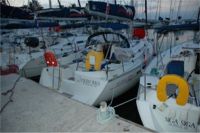
|
Day 2 - Sunday May 14, 2006
The next morning the provisions were delivered and we had
the problem of finding places for all that food. We also needed to
inventory everything on the boat down to the number of pieces of
silverware. We found a couple of discrepancies in the provisions (no apple
pie, smoked oysters nor corn flakes) but after reporting the problem, the
provisions guy showed up with the missing stuff (except the smoked
oysters. We got canned tuna instead). At 10:00 am there was a
meeting where we first got introduced to the crew of the lead boat and the
captains and some of the crew of each of the other boats in the flotilla.
The flotilla captain was Dunbar, a seasoned but young mariner, Wendy the
hostess and social director of the trip and Roydan, the technician and
mechanic. In the floatilla were two 34 foot monohulls (including ours),
three 40 foot monohulls, two 50 foot monohulls, one 43 foot catamaran and
the fleet captains boat, a 47 foot catamaran. |
| An overview of the trip was
presented as well as the details for our first days sail from Road Town
harbor to Marina Cay, which is just off the NE corner of Tortola. We were
free to leave as soon as we were ready and asked to get there before 4:30
pm. It is only 6 or 7 nautical miles so no problem with that. Since it was
Mother's Day, Chris found a place with internet access at the marina and
sent a Mother's Day message to both Carrie and Geri. Chris and I
motored out of the marina around 12:30 pm. The weather in the Francis
Drake Channel was clear with some puffy clouds, winds of about 11-15 knots
from the ESE. |
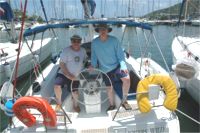 |
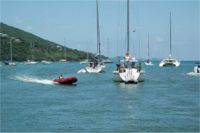 |
Since I had never captained
a boat this size before, I was a bit apprehensive about putting up the
sails for the first time but except for some sticky sail slides and pesky
lazyjacks they went up fairly easily and the boat was as steady as a rock.
It was an easy beat up to Marina Cay where we arrived around 4:30. Since
we were one of two 34 foot boats in the flotilla and all the rest were
larger, that meant they were also faster. That usually made us last or
second to the last boat into the anchorage. |
| But I noticed on the way up that
our mainsail had a really bad shape due to the lazyjacks being too tight.
(Lazyjacks are the lines on either side of the sail that help keep it in
place when it is lowered). I readjusted them and the topping lift after we
were anchored and hoped that would help our speed a bit. Since we
found that it costs between $25 and $35 per night to hook up to a mooring,
we decided to anchor for the night. The captain of the lead boat came out
in his dinghy to show us where to drop the hook and give us some tips on
how to get it set. Except for a twisty chain that had not been used for a
while, it was easy and we were squared away in a few minutes. |
| Once out of the breeze, it gets
hot really quickly so we figured out how to fit the wind scoops to the
hatches. They are rather large nylon scoops that are placed over the deck
hatches to grab more air. We had one for each sleeping quarters and they
were really a big help in keeping it reasonably comfortable below. After
cleaning up a bit we took the dingy to shore to Pussers restaurant for a
coldie and dinner. I had coconut battered, freshly caught wahoo and it was
great. Chris had the equally good curie chicken. The price was not bad
either. It was a great first day on the water |
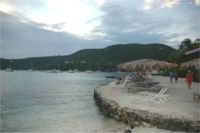
|
Day 3 - Monday May 15, 2006
Except for waking up a few times to check the anchor, and to close the
hatches to keep out the light rain that fell sometime overnight, we slept
like a babies with the gentle rocking of the boat to the swells that
rolled into the anchorage. But, the sun rises in the BVI at 5:30 this time
of year. I found it impossible to sleep after sunrise so I became an early
riser. Chris and I usually spent the early morning tidying up the boat,
doing dishes, picking up stuff and having breakfast. At 8:00 am we went to
the captains meeting on the lead boat the huge 47 foot catamaran. There we
got the plan for the day. Wendy, the flotilla hostess talked about things
to see and do at the day's stops, dinner arrangements etc. She told us we
would be stopping for lunch across the channel at The Baths, an unusual
rock formation on the south end of Virgin Gorda, noted for good snorkeling
and interesting sights. For the evening we would be at the Bitter End
Yacht Club in North Bay of Virgin Gorda. The captain gave us a couple of
compass headings (in case we couldn't figure it out I guess) and talked
about the entrance to North Bay. There are actually two channels into the
bay but one is very shallow and narrow and we were told not to use it. |
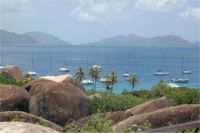 |
We left Marina Cay around 10:30
am and headed across the channel to the Baths. The weather again was clear
with a few puffy clouds. The winds were a bit stronger at an estimated
18-22 knots and seas 2-3 feet. On this crossing I discovered that boat had
a pretty strong weather helm (wants to turn into the wind) at these wind
speeds so it was a lot of work to keep it pointing in the right direction.
We also heeled quite a bit, maybe up to 35 degrees or so a few times
during the short trip across to the Baths. |
| We anchored there and took the
dingy ashore. Again as soon as you are out of the wind, it got pretty hot
so Chris and I decided to forget the snorkeling and headed up the path to
the bar on top of the hill. It was a long trek up but the view was
spectacular. We had a pesky sea gull begging from us most of the time but
both the beer and the rum "painkiller" were quite refreshing. I
guess we had something to eat too but I don't seem to remember what it
was. Around 2:00 we left the Baths had headed for North Bay. This
time I decided to put a reef in the main and see if the boat would handle
a bit easier. It did. It probably went just as fast too but I couldn't
tell as the knot meter died on the way to the Baths. It was a pleasant
sail around the west side of Virgin Gorda, around the north side of
Mosquito Is. to the entrance to the anchorage and the Bitter End Yacht
Club. There were not many places to anchor so Chris and I decided to blow
the $35 and pick up a mooring. Once again the captain came out in the
dingy to give us a hand with the mooring (a permanent anchor imbedded in
the bottom with a chain leading to a floating ball with a length of line
attached that you tie up to). After cleaning up, we went ashore for the
free rum punch on the beach supplied by Wendy. |
| After a couple of these and
taking a walking tour of the Yacht Club we realized this was a really
expensive place so we decided to do dinner on the boat that night. We had
double cheeseburgers and corn on the cob on the grill. Nothing in the
dining room could have been better. Roydan came over to our boat and
pulled and cleaned the knot meter. This is a non-trivial job as it
essentially puts a hole in the bottom of your boat when pulled. He managed
to get it out and back in while only taking on a couple gallons of water,
which he painstakingly sponged up and took out in a bucket. It was another
great day! |
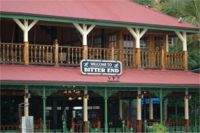 |
Day 4 - Tuesday May 16, 2006
Today will be the biggest sail so far on the trip. We are
headed for Anagada, the northern most island in the BVI. It is unlike the
other volcanic islands. It is an atoll, formed out of coral and has very
little vertical development. The highest spot is around 14 feet. The other
islands have peaks of up to 1500 feet. The captain told us we would not be
able to see it until we were within 6 nautical miles or so and it is 14 nm
from Virgin Gorda. It also has a very shallow and narrow entrance to the
anchorage (and a shallow anchorage too as we were to find out). We
left Virgin Gorda around 12:30 am and were treated to a sailors dream.
Winds 15-18 kts from the east, a dead on beam reach! Seas 3-4 ft, skies
the now familiar clear with puffy clouds (mostly over the islands) and we
are haulin' butt. The now working knot meter topped 6.5 kts a few of
times. The hull speed of this boat is around 6 kts so that is a big deal. |
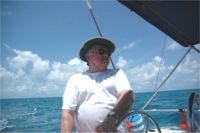 |
The captain anchored at the
entrance to the Anagada channel to be sure no one ran into the reef there.
Just as we entered the channel, one of the big monohulls gets on the radio
to tell the captain that they are aground in the anchorage. He passes us
and takes off to help pull them off. We proceeded up the channel keeping a
careful eye on the depth gauge. Before leaving the dock in Road Town, the
person showing us the boat said it would be a good idea to keep the depth
no less than 10 feet as the boat draws 4.3 and that would leave a good
safety factor. Well, I am dead in the middle of the channel and it says
5.5 feet! So much for that advice. |
| As we enter the anchorage, I
head for a mooring ball at the far end. The captain is on the back of his
boat in the process of pulling the big boat out if the sand but I get his
attention (at least I thought I did), and point to the ball and he nods
his head (at least I think he did). So I head for the ball but soon
realize that I too am plowing a furrow in the sand with the keel. The
depth sounder says 2 feet so now I know how far down the transducer is
located! With lots of power and a 180 turn I plow our way out just as I
see the captain heading my way in his dinghy. He turns around as he sees I
am clear now. I head for another ball closer in. I see another boat
heading for the same ball. I point to it and him to indicate it is his. He
goes by anyhow so I decide to take it. As I ease up to the ball, Chris is
on the foredeck with the boathook to grab the pennant. As he does, the
boathook comes apart and the hook end falls into the water. Now what!
Fortunately a couple in a boat already moored nearby jump into their dingy
and are there in a flash. They grab the pennant and hand it to Chris and
we are finally tied to earth again. Whew! Now I know why boaters always
have a coldie after they get into the anchorage. I forget the exact words
from the English guy that helped us but they were something like,
"when I saw the bloody hook fall off I knew you were splocked".
Chris did retrieve the missing end of the boat hook before we went ashore
to the cheers of the crew on the English boat. Chris bought them a bottle
of wine that night at dinner. |
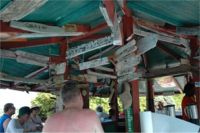 |
The rest of the day was spent at
Loblolly Bay on the north side of Anagada. It was a 20 minute ride over
there on what they call a taxi but it is more like a jitney. It was a very
bumpy ride over coral rock and sand roads. The driver was obviously adept
at dogging those funny brown piles in the road that we later found out
were left by cattle roaming through the scrub. We ended up at a nice sand
beach with lots of shallow coral reefs to snorkel on. But, it was hot so
Chris and I again opted for the shade of the outdoor bar, tried out some
more local beer, spent some time in the hammock. |
| At least I did. Chris
found out that the one he brought along was not up to the task of holding
his large frame. I heard a "pop, pop, pop, pop, thunk" as one by
one the strings broke until he landed on the ground. To bad I didn't get a
picture of that. After the ride back we got cleaned up and headed to
the Lobster Trap restaurant for dinner. We had planned to eat on the boat
but were encouraged to support the local facilities since Anagada is off
limits to most cruisers because of the difficulty of getting in there.
That turned out to be a mistake. Second most low point of the trip was the
8 measly shrimp I got for twenty five bucks. I left feeling cheated as
well as hungry. And Chris discovered that the bottle of wine he so
graciously bought for the English couple was $75. A real budget buster
this dinner! |
Day 5 - Wednesday May 17, 2006
The night in this anchorage was pretty rolley, like imagine
being anchored in a wash machine! But today was to be another great
sailing day. We found out in the captain's meeting that we would be going
24 miles to Cane Garden Bay, the longest sail of the trip. He expected it
to take us around 5 hours and suggested we get an early start. I laid out
the route on the chart (as I did every day) and copied the headings and
distance for each leg on a card that I taped to the helm as it is hard to
hold a chart in the wind in the cockpit. I also loaded significant
waypoints into the GPS. We left the anchorage at 9:30 AM to find
southeasterly winds at 15-20 kts. The sail down to Cane Garden Bay was
mostly a beam reach like we had yesterday except with a few legs more
upwind. The skies were, guess what, clear with puffy clouds over the
islands and the seas were 2-3 feet. This was another day made for sailing
and the log shows we topped 7 knots for a few seconds! |
| We anchored near the north end of
Cane Garden Bay around 2:30 PM. After tidying up the boat we went ashore
to test a few local brews and have a look around. There are a series of
restaurants and bars along the beach as well as some souvenir shops etc.
But tonight was to be another meal on the boat so we headed back before
dark. For dinner we dug the steaks out of the fridge and grilled them with
more corn on the cob. Later on the captain came by and asked if we wanted
to go for a night sail on the big catamaran. |
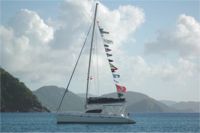
|
| We said sure, expecting to take
a sail around the island or around the bay. But instead the captain
motored all the way to Norman Island, which took a couple of hours.
Everyone on the boat (around 25 or 30 people) was ready to
hit the sack even before we turned around to come back. People were
sleeping everywhere, on deck, in the saloon etc. I guess he thought we
were more of a party crowd than we really were. We were to find out later
that one of the biggest party spots in the BVI is on Norman Island but
nobody was in a mood for it that night so he headed back to Cane Garden
Bay. After the long ride back, we were all anxious to get some sleep. My
last entry in the log for this day is at 1:15 AM (remember the sun comes
up at 5:30). |
Day 6 - Thursday May 18, 2006
Today's sail is to the island of Jost Van Dyke, the home of
the famous Foxy's bar and restaurant. But first, we are going to have a
regatta, that is a sail boat race from Cane Garden Bay, across the channel
and counter clock wise around Sandy Cay to the finish line at Green Cay on
the east end of Jost Van Dyke. The rules are, mainsail only at the start
with engine running (so we have some control and don't run into each
other). Once clear of the pack, jib up and engine off. Both the channel
crossing and the final leg will be downwind runs. The scoring will take
into account the size of the boats by some mysterious formula that only
the captain knows. We will use the usual timed start with horns a 5 and 2
minutes before and at the start. Chris and I have never gybed the boat
(had the sails change sides while going down wind) so we headed out of the
bay early to do some practicing. After we heard the 5 min gun we headed
back toward the starting line and then paralleled the line but on the
front side. At the two minute gun, we were just about to the pin at the
end of the line so we went 50 seconds out, then did a 180 which put is
behind and parallel to the line on a starboard tack (which has the
right-of-way over boats on a port tack). When the starting gun went off we
were about 50 yards inside the pin. We just turned downwind and were about
the second boat over the line. Great start if I do say so myself. Now for
my secret weapon, the wing-on-wing maneuver. That is to sail just lightly
off dead downwind, put the main on the lee side and the jib on the other.
This is normally done with a whisker pole which holds the jib further out
from the boat but we didn't have one of those. But the captain had given
me some advice earlier that you can hold the jib out if you free up the
top so the wind will fill there and keep the bottom from collapsing. So
before the race I moved the jib sheet cars further back to let the top of
the jib open up. It sort of all worked except the wind was really fluky
for the first several hundred yards so the main kept flopping from one
side to the other and kept Chris busy hauling in and hauling out the main
sheet. But we got around the island ok and were heading for the finish
line. Just ahead and a bit down wind was the other 34 foot boat. We were
catching them as we were stealing some of their wind. We tried the
wing-on-wing thing again and we were now passing them. The other boat got
the idea and went wing-on-wing too but we are still faster and about ½ a
boat length in front and about 200 yards from the finish. Then we get a
wind shift, and another accidental gybe so the main flops to the other
side and blocks the jib. But we hold course and watch the other boat
slowly pull ahead and beat us by ½ a boat length. DAMN! But, who cares,
we weren't really racing anyhow right? |
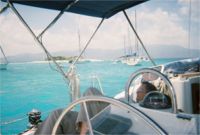 |
After getting our adrenalin up it
was time to slow down again so we all dropped anchor at Green Cay to chill
for lunch. There is a nice sandy beach there and a small reef and some of
the folks went snorkeling. But instead of that, Chris suggested we use the
standing invitation we had from the captain to visit the lead boat
"anytime". So Chris grabbed a bottle of Tequila and some
Margarita mix and we took the dingy over to the big cat for some island
time. Before long the Tequila was
gone and we were all pretty relaxed. |
| Wendy kept her cool as she does not drink but was busy with her hobby of making beaded
jewelry. After our nice chat with the lead crew we went back to our boat to
head for our evening stop. |
| It was a short hop around the
south side of Jost Van Dyke to Great Harbor and the anchorage. We dropped
the hook in about 25 feet of water, tidied up the boat and took the dingy
to shore to explore the famous Foxy's. Foxy's started out as a small
waterside bar run by a guy who had been a seaman for many years but
returned to his home to settle down. He supposedly entertains his guests
by telling them things about their home town that they don't even know and
by playing bluesy calypso music. I never did see him but Chris caught a
glimpse of him just after we got ashore. |
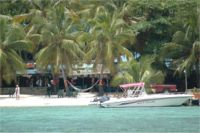 |
| The place is now a very large
waterside restaurant and bar with a very small stage. During dinner a
small band come on stage to play some calypso music but no more Foxy. We
did some shopping in the gift shop and had an early dinner. I thought the
BBQ rib dinner was great but Chris was not as impressed. Anybody who puts
sautéed garlic in the vegetables is a friend of mine! Since we didn't get
much sleep the night before, we headed back to the boat around 9:00 pm to
catch up. |
Day 7 - Friday May 19, 2006
Today it's off to Norman Island. This will be mostly an
upwind sail so lots of tacking and not much groundspeed. We left Jost Van
Dyke around noon and beat our way around the west end of Tortola, through
the Thatch Island Cut, between Little Thatch Island and Frenchman's Cay
and into the Francis Drake Channel. We headed a long way east trying to
minimize the number of tacks but it still took several and Chris was
starting to threaten mutiny if I made him do any more. But one last one
took us northeast and into The Bight on Norman Island. We got there around
3:00 pm and picked up a mooring as no anchoring was allowed there. By now
I was feeling really guilty that I had yet to go snorkeling or take more
than a couple of pictures with my underwater cardboard camera. So the plan
for the afternoon, or so I thought, was for us to head to the caves, a
popular snorkeling spot just around the corner from the anchorage. But
Chris had other plans. He grabbed his bottle of single malt scotch and
told me to drop him off at the captain's boat on my way to the cave. So I
did. He appeared to be well received as I dropped him off. I then headed the dinghy around the point to The
Caves and tied up to the mooring with the several others that had gotten
there before me. I pulled on my flippers and went over the side made the
short swim to the caves. |
| There were lots of fish and
interesting rock formations and some grey looking coral but I guess living
in FL spoiled me as I expected a much more colorful scene. But I made
several dives to get closer looks at the fish and sea urchins for ½ hour
or so. I shot a bunch of pictures, then climbed back into the dingy (no
easy feat I might add) and headed back to the boat. I was going full tilt
with the dingy on plane (it wouldn't do that with both of us in it) and as
I came around the point I see a big flat rock dead ahead and about 1 ½
feet under water. I made a really quick hard left and managed to miss it
and still stay in the boat. |
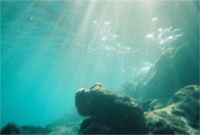 |
| After cleaning up a bit I headed
to the captain's boat to join Chris. Soon all the rest of the flotilla
participants came as well for dinner. This was to be our last night of the
trip and the lead crew was throwing a BBQ dinner on the big cat. We had
one of the better meals of the trip with BBQ chicken and ribs, vegetables,
salads and banana bread etc. etc. It turns out that Wendy is a caterer in
the off-season and that lady does know how to cook. All together there are
over 40 people in the flotilla and we all got on the boat easily. After
dinner there was an awards ceremony where they gave trophies for the boat
race. I knew we were not getting any winning prizes and I was just hoping
we were not going to get the "Dead Ass Last" trophy I had seen
in the assortment of those to be given out. Thanks to Captain Dunbar's
mysterious formula, we didn't, even though we had been the last boat to
physically cross the line. There were a few songs and guitar accompaniment
from one of the younger cruisers, a song by Royden and then it was time to
really party. |
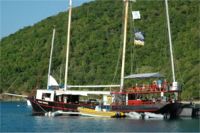 |
Anchored in The Bight on Norman
Island is the Willy T, a true party boat. It is probably about 100 feet
long. On the foredeck is a restaurant and aft a bar and small dance floor.
There is another deck above the dance floor with some tables and the boats
most famous part, a small platform way at the stern to be used for jumping
in the water, about 20 feet below. And if you jump from this platform into
the water, you get a free T-Shirt. But there is one important caveat to
getting the T-Shirt. You have to jump nude! |
| There seems to be no shortage of
folks willing to do this as several, both guys (ugh) and girls did during
our short stay there and I saw several more wearing the "I came, I
saw, I jumped" shirts. One party was a girl celebrating her 21st
birthday. She and her two girlfriends did the deed while her dad held her
clothes! Strange huh? No one in our party was brave enough to
go for the T-Shirt but Chris made it his mission to meet and chat with
everybody on the boat, and he did. He also showed some locals how to dance
(using one of the local's girl friends as a prop) and got his picture
taken with several. On the upper deck he ran into a family from Charlotte.
And after some conversation we found that they sailed a Catalina 22 on
Lake Norman (just like we do) and in fact Geri and I had met them a picnic
at the Lake Norman Sailing Club. Small world huh? After what seemed like a
long night of partying, I convinced Chris it was time to head for the boat
around 11:00 PM. |
Day 7 - Saturday May 20, 2006
Well this is it, our last sail before turning in the boat.
We needed to have the boat back at The Moorings dock by noon and it was
about a 1 ½ hour sail across the Francis Drake Channel one last time.
After breakfast we packed all our gear and tried to get things organized
before heading back. Around 10:00 we slipped the mooring, motored out of
the anchorage and hoisted the sails. After rounding the point of The
Bight, we took a heading of 30° on the compass, which took us inside of
Pelican Island and straight for the white water tanks on the entrance to
Road Harbor about 4 nm away. The wind was 12-15 knots from the ENE which
put us just off the wind from a full beat. |
| The weather was again clear with
the now familiar puffy clouds and is was a great and relaxing last morning
on the water. We didn't talk much on the way back but tried to soak in as
much of the scene one last time as we could. Once in Road Town Harbor we
called the Moorings in Channel 12 on the VHF radio and they gave us a slip
number and advised which side to rig the fenders and docklines. About
11:35 am I managed to slip into the dock without hitting anything and got
a "nice job captain" from the dock hand. Nice way to end a week
on the boat. |
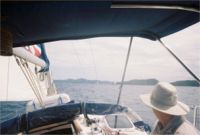 |
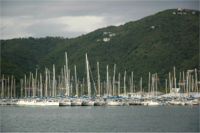 |
There was a furry of activity now
getting our stuff off the boat, getting inventory checked by the Moorings
folks to make sure it was all still there. We were short one of our life
jackets as it was still in the dinghy when one of the Moorings folks ran
off with it but that didn't seem to bother them. We also told them about
our broken boathook and they seemed OK with that too. Once in the marina,
there is no wind so it gets really hot quickly so we were anxious to get
checked out and find somewhere cooler to relax. |
| We made arrangements for a hotel
for the night, got a cab to take us there, got cleaned up and spent the
afternoon wandering around Road Town. The next morning we caught our
flight home. This was a great trip and it was wonderful sailing and
wonderful companionship with Chris. I hope to do it again. |
The Boat
The boat is a Moorings 332 which is a Beneteau 332 built
for the Moorings and outfitted to their requirements. Here are some specs:
Length overall 34' 0"
Length at the waterline 30' 6"
Beam 7' 8"
Draft 4'6"
Displacement 9900 lbs
Sail Area 580 sq ft |
| The boat was equipped with a 120%
genoa on a roller furler. The main used lazyjacks and a "SailMate"
system which makes it easy to lower and stow the sail. At the helm was a
compass, GPS, depth sounder, knotmeter and auto pilot. On the bow was a 30
# CQR anchor with 100 ft of chain and another 200 feet of nylon rode, all
collected by an electric windlass. Also on board was a second anchor, a 30
lb Danforth with 200 ft of nylon rode. Over the cockpit was a bimini top
for shade as well as a dodger over the companionway. |
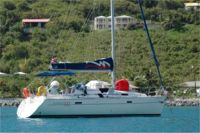 |
| We furled the dodger before we
left the dock and never put it back up until we returned. It was really
just in the way as it blocked access to the traveler and also the breeze
to the cockpit and my bunk vent. The galley had a propane two burner stove
with oven, a dual stainless steel sink, a pressure fresh water system and
an "in the counter" fridge / freezer. The head was equipped with
a sink, extendable spout / shower head and of course the manual (pump,
pump, pump-a-lot) marine head. The huge house battery (about three times
the size of a car battery) was charged by an 80 amp alternator mounted on
the Yanmar 27 hp diesel. We had to run it about 3 hours a day at 1600 rpm
or more to keep the battery charged up. There was also a separate starting
battery for the diesel. |
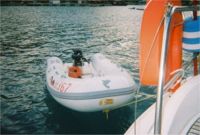 |
Dragging behind was
our 10 foot rigid inflatable dingy with a 15 hp Mercury motor. It would
not plane with both of us in it but still was a dependable runabout and
pickup truck to get us and our stuff to shore and back. The dingy had an
anchor and a portable all round white light for night use. |
|
|
|
|
More BVI pictures HERE |





